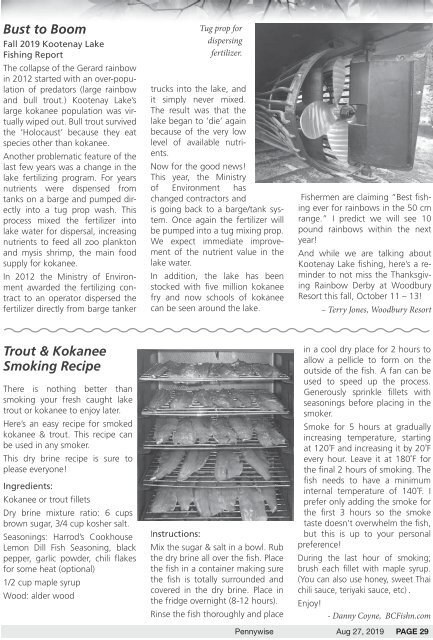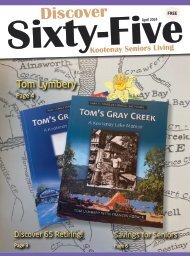Aug 27, Pennywise – Castlegar, Slocan Valley
Total coverage of the City of Castlegar, Genelle, South Slocan, Crescent Valley, Thrums, Slocan Park, Winlaw and Slocan.
Total coverage of the City of Castlegar, Genelle, South Slocan, Crescent Valley, Thrums, Slocan Park, Winlaw and Slocan.
Create successful ePaper yourself
Turn your PDF publications into a flip-book with our unique Google optimized e-Paper software.
Bust to Boom<br />
Fall 2019 Kootenay Lake<br />
Fishing Report<br />
The collapse of the Gerard rainbow<br />
in 2012 started with an over-population<br />
of predators (large rainbow<br />
and bull trout.) Kootenay Lake’s<br />
large kokanee population was virtually<br />
wiped out. Bull trout survived<br />
the ‘Holocaust’ because they eat<br />
species other than kokanee.<br />
Another problematic feature of the<br />
last few years was a change in the<br />
lake fertilizing program. For years<br />
nutrients were dispensed from<br />
tanks on a barge and pumped directly<br />
into a tug prop wash. This<br />
process mixed the fertilizer into<br />
lake water for dispersal, increasing<br />
nutrients to feed all zoo plankton<br />
and mysis shrimp, the main food<br />
supply for kokanee.<br />
In 2012 the Ministry of Environment<br />
awarded the fertilizing contract<br />
to an operator dispersed the<br />
fertilizer directly from barge tanker<br />
Tug prop for<br />
dispersing<br />
fertilizer.<br />
trucks into the lake, and<br />
it simply never mixed.<br />
The result was that the<br />
lake began to ‘die’ again<br />
because of the very low<br />
level of available nutrients.<br />
Now for the good news!<br />
This year, the Ministry<br />
of Environment has<br />
changed contractors and<br />
is going back to a barge/tank system.<br />
Once again the fertilizer will<br />
be pumped into a tug mixing prop.<br />
We expect immediate improvement<br />
of the nutrient value in the<br />
lake water.<br />
In addition, the lake has been<br />
stocked with five million kokanee<br />
fry and now schools of kokanee<br />
can be seen around the lake.<br />
Fishermen are claiming “Best fishing<br />
ever for rainbows in the 50 cm<br />
range.” I predict we will see 10<br />
pound rainbows within the next<br />
year!<br />
And while we are talking about<br />
Kootenay Lake fishing, here’s a reminder<br />
to not miss the Thanksgiving<br />
Rainbow Derby at Woodbury<br />
Resort this fall, October 11 <strong>–</strong> 13!<br />
<strong>–</strong> Terry Jones, Woodbury Resort<br />
Trout & Kokanee<br />
Smoking Recipe<br />
There is nothing better than<br />
smoking your fresh caught lake<br />
trout or kokanee to enjoy later.<br />
Here’s an easy recipe for smoked<br />
kokanee & trout. This recipe can<br />
be used in any smoker.<br />
This dry brine recipe is sure to<br />
please everyone!<br />
Ingredients:<br />
Kokanee or trout fillets<br />
Dry brine mixture ratio: 6 cups<br />
brown sugar, 3/4 cup kosher salt.<br />
Seasonings: Harrod’s Cookhouse<br />
Lemon Dill Fish Seasoning, black<br />
pepper, garlic powder, chili flakes<br />
for some heat (optional)<br />
1/2 cup maple syrup<br />
Wood: alder wood<br />
Instructions:<br />
Mix the sugar & salt in a bowl. Rub<br />
the dry brine all over the fish. Place<br />
the fish in a container making sure<br />
the fish is totally surrounded and<br />
covered in the dry brine. Place in<br />
the fridge overnight (8-12 hours).<br />
Rinse the fish thoroughly and place<br />
in a cool dry place for 2 hours to<br />
allow a pellicle to form on the<br />
outside of the fish. A fan can be<br />
used to speed up the process.<br />
Generously sprinkle fillets with<br />
seasonings before placing in the<br />
smoker.<br />
Smoke for 5 hours at gradually<br />
increasing temperature, starting<br />
at 120˚F and increasing it by 20˚F<br />
every hour. Leave it at 180˚F for<br />
the final 2 hours of smoking. The<br />
fish needs to have a minimum<br />
internal temperature of 140˚F. I<br />
prefer only adding the smoke for<br />
the first 3 hours so the smoke<br />
taste doesn’t overwhelm the fish,<br />
but this is up to your personal<br />
preference!<br />
During the last hour of smoking;<br />
brush each fillet with maple syrup.<br />
(You can also use honey, sweet Thai<br />
chili sauce, teriyaki sauce, etc) .<br />
Enjoy!<br />
- Danny Coyne, BCFishn.com<br />
<strong>Pennywise</strong> <strong>Aug</strong> <strong>27</strong>, 2019 PAGE 29


















